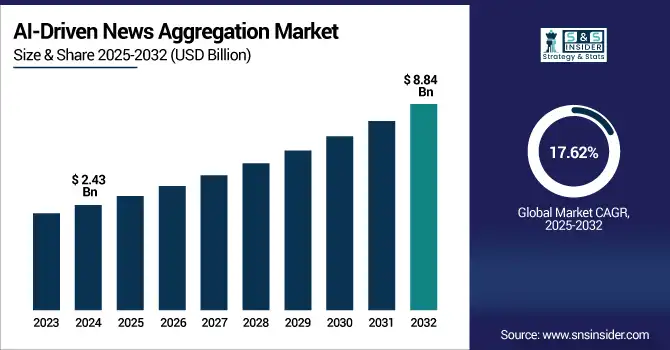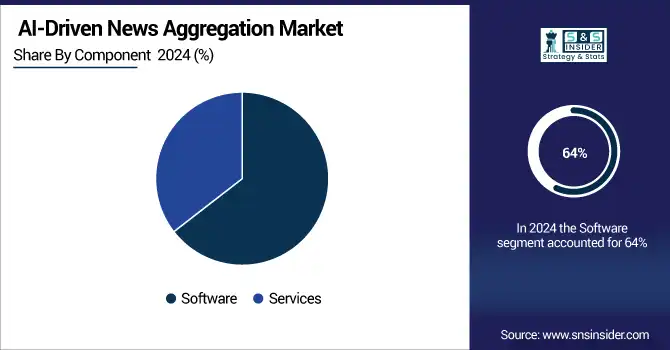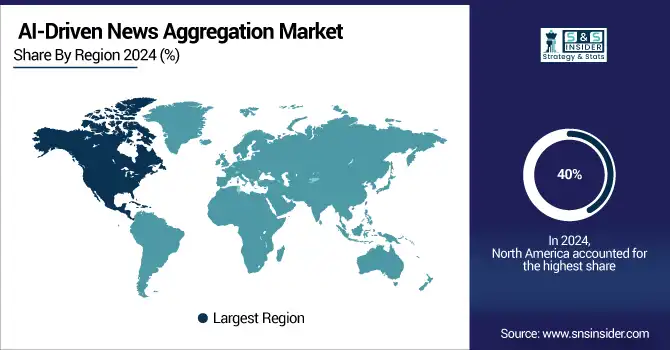AI-Driven News Aggregation Market Report Scope & Overview:
AI-Driven News Aggregation Market size was valued at USD 2.43 billion in 2024 and is expected to reach USD 8.84 billion by 2032, growing at a CAGR of 17.62% over 2025-2032.

To Get more information on AI-Driven News Aggregation Market - Request Free Sample Report
The AI-Driven News Aggregation Market growth is primarily fueled by the rising demand for personalized, real-time, and bias-free news experiences. Increasing volumes of digital content and social media data have created a need for intelligent filtering and summarization tools.
AI systems, such as News360 process content from over 100,000 sources, clustering and ranking news for each user based on semantic and interest-graph analysis, ensuring high relevance. Advancements in natural language processing (NLP), machine learning, and sentiment analysis continue to enhance content accuracy and user engagement.
Institutions, such as the U.S. Department of Justice and the Copyright Office are actively researching the use of AI in detecting misinformation and improving content credibility.
Moreover, tools such as the Washington Post’s Heliograf leverage AI-driven A/B headline testing, achieving an 18% increase in click-through rates, showcasing how media organizations are optimizing content delivery. The surge in mobile and smart device usage also drives adoption across individual and enterprise users, further accelerating market expansion
U.S. AI-Driven News Aggregation Market size was valued at USD 0.68 billion in 2024 and is expected to reach USD 2.46 billion by 2032, growing at a CAGR of 17.38% over 2025-2032.
The U.S. AI-Driven News Aggregation Market is growing rapidly due to rising demand for real-time, personalized content, increased mobile usage, and advancements in AI technologies, such as NLP and sentiment analysis, enhancing news delivery, accuracy, and user engagement across platforms.
Market Dynamics:
Drivers:
-
Rising Demand for Real-Time, Personalized News Experiences Among Digital Consumers Across Platforms Is Fueling Market Expansion Rapidly
The growth of the AI-Driven News Aggregation Market is primarily due to the high demand for personalized, on-demand, and non-biased news experiences. With the rising volumes of digital content and social media data, there are new needs for filter and summary tools that can help read minds intelligently.
In the U.S., 82% of adults consume news via digital devices, with 36% using mobile news apps daily. This surge supports growing demand for AI-driven tools, as NLP, machine learning, and sentiment analysis improve content relevance, personalization, and engagement.
-
Moreover, a Salesforce report indicates that global daily use of AI among desktop workers has surged by 233% in the last six months, with three in five now using AI tools daily demonstrating the growing reliance on AI technologies across sectors.
-
Notably, 67–75% of digital consumers report loyalty to the same news brands across platforms, rising to 75% among mobile users, reflecting the strong retention potential of well-personalized content.
Increase in use of mobile devices and AI adoption by media platforms for content delivery, reduction of misinformation, and improve user engagement and retention.
Restraints:
-
Concerns Over Misinformation Amplification and Algorithmic Bias Pose Ethical Risks to Market Adoption and Credibility
Aggregators that rely heavily on AI can spread misinformation by selecting content according to how likely it is to generate engagement, rather than how truthful it is. Biased or sensationalist content can result from flawed training data and poor editorial oversight. The black-box nature of these models means it is difficult to resolve attributions or evaluate credibility, which in turn erodes public trust particularly in politically charged situations. Regulatory scrutiny is growing, forcing platforms to do more to ensure fair and responsible outcomes. While there is not transparency and fact checking, there will remain ethical and legal impediments to mass adoption and investor faith in the marketplace.
-
A recent Wired report uncovered a pro‑Russia disinformation campaign (Operation Overload) that used readily available AI tools to produce 587 deceptive content pieces between September 2024 and May 2025 compared to 230 the previous year demonstrating how AI can rapidly amplify false narratives.
Opportunities:
-
Growing Integration of Voice Assistants and Smart Devices for News Consumption Offers Immense Potential for AI Aggregation Platforms
Voice-activated assistants, such as Alexa, Google Assistant and Siri are becoming a central way to consume bite-size news. This lends itself to great potential for AI aggregators to send short-form, context-sensitive updates through smart speakers, car infotainment systems, and wearables. These integrations lift daily engagement by folding news into routines such as commuting or cooking. Fueled by AI voice synthesis and sentiment analysis, audio-centric, screen-light user consumption will promote wider distribution with integrations or partnerships with device makers for bundled or native content delivery
-
As of 2025, the U.S. has 154.3 million voice-assistant users, including 77.6 million Alexa, 92.4 million Google Assistant, and 87.0 million Siri users spanning smart speakers, phones, cars, and wearables.
-
Additionally, 62% of Americans aged 18 and above regularly use voice assistants on such devices.
-
Alexa alone supports over 100,000 skills, including news flash briefings and voice-enabled routines, making it a robust platform for AI-driven news delivery.
Challenges:
-
Lack of Standardized Evaluation Metrics for AI News Aggregators Hinders Trust, Benchmarking, and Adoption Across Markets
The lack of measurements and benchmarks to gauge accuracy, bias-mitigation, and algorithmic performance in the AI news aggregation ecosystem. This lack of benchmarks makes it difficult for consumers and businesses to compare services or claims of being fair and transparent. This lack of clarity does not help our platform credibility, it does not support institutional trust, and it does not support investment. Regulators also struggle to enforce compliance in the absence of standardized assessment. This can only be solved through industry-wide standards and third-party audits. Until then, partial definitions of “quality” AI aggregation will prevent mainstream adoption and global scale.
-
In Canada, 85% of news consumers want transparency around how AI is used in journalism, and 75% want AI content clearly labeled.
-
A Pew/Brookings-style survey found that 82% of the U.S. voters believe tech companies cannot be trusted to self-regulate AI and support multi-stakeholder oversight.
-
Additionally, a Reuters Institute survey of ~100,000 people across 47 countries revealed that 52% of U.S. respondents are uncomfortable with AI-generated news, with only 23% expressing comfort highlighting persistent skepticism toward AI in journalism.
Segmentation Analysis:
By Component
Software segment dominated the AI-Driven News Aggregation Market share of about 64% in 2024 due to its scalability, rapidly deployable, easy to integrate with a company's existing virtual infrastructure, and is scalable. It supports real-time processing data at scale, advanced analysis, and dynamic updates, and is widely adopted in business for automated and personalized news recommendation. Its cross-platform flexibility also helps drive enterprise adoption across industries, such as media, finance and education.
Services segment is expected to grow at the fastest CAGR of about 18.83% over 2025–2032, owing to increase in requirement for custom implementation, training, and AI integration support. Companies are increasingly using managed services to keep their AI systems running and performing well, especially in a lack of in-house AI expertise. Consulting services that provide custom aggregation solutions to help users draw better conclusions, monitoring and user engagement are driving growth as well.

By Application
Personalized News segment dominated the AI-Driven News Aggregation Market with the highest revenue share of about 30% in 2024 due to the increasing consumers demand for content that mirrors their behavior, interests, and browsing history. Personalization engines driven by AI increase user engagement and retention by weeding out junk stories, serving up relevant updates on-the-fly, and raising the value of news sites for advertisers and subscribers that want more clicks and loyalty.
Content Recommendation segment is expected to grow at the fastest CAGR of about 19.33% during 2025–2032, as a rising innovation in machine learning algorithms for improved content discovery and cross-platform engagement. Such systems encourage users to discover new topics and sources, thereby enhancing interaction time and user satisfaction. Increasing need for predictive analytics and contextual content placement is also expected to drive the growth of this segment in both consumer and enterprise applications.
By End-User
Media & Entertainment segment dominated the AI-Driven News Aggregation Market with the highest revenue share of about 30% in 2024 as they invested heavily in real time news delivery, audience analytics, and competitive content strategies. AI is used by media houses for personalized headlines, trend tracking, and user experience enhancement. This segment is early to increase the use of AI aggregation solutions due to high digital penetration and growing preference for consumption of the dynamic content.
Individuals segment is expected to grow at the fastest CAGR of about 19.68% during 2025–2032 as end-users demand personalized, spam-free news experiences on all devices. With the ubiquity of smartphones, smartwatches and voice assistants, we are happy to adopt AI tools that enable us to consume the news at greater speed. Greater transparency of algorithmic curation and the prevalence of freemium models also contribute to participation, particularly from younger, digitally savvy users who have a preference for personalized, real-time news feeds.
By Deployment Mode
Cloud segment dominated the AI-Driven News Aggregation Market with the highest revenue share of about 60% in 2024, and is expected to grow at the fastest CAGR of about 18.37% during 2025–2032. This growth is driven by the cloud’s ability to scale, change and be cost-efficient in managing large amounts of real-time data. Cloud-based platforms help to streamline the use of AI tools, and expedite the roll-out of updates, anywhere, anytime on any device. Cloud based models are preferred by media companies and organizations for enabling dynamic content delivery, improving user experience and reducing maintenance/infrastructure spend substantially.
Regional Analysis:
North America
North America dominated the AI-Driven News Aggregation Market with the highest revenue share of about 40% in 2024 as the region has high adoption rate of advanced digital technologies, higher number of smartphone users, and existence of major tech giants. Heavy investment in AI technologies, extensive adoption of personalized content platforms and need for real-time news analytics from enterprises and media organizations also served the region well in leading in this segment.
-
A June 2025 Reuters Institute report found that 15% of Americans under 25 use AI chatbots such as ChatGPT and Gemini weekly for news, compared to 7% overall.
-
The same report highlighted a post-January 2025 trend where more Americans now get news from social and video platforms than from traditional TV or news websites marking a significant shift in consumption behavior that fuels AI aggregator adoption.
The U.S. is dominating the AI-Driven News Aggregation Market due to its advanced AI ecosystem, strong digital infrastructure, and high adoption across media platforms.

Get Customized Report as per Your Business Requirement - Enquiry Now
Asia Pacific
Asia Pacific is expected to grow at the fastest CAGR of about 20.13% during 2025–2032, due to the fast-paced digitalization, increase in the internet user base, and increasing requirement of local language news content. Governments and enterprises in India, China, and Southeast Asia are actively promoting the adoption of AI to enhance information accessibility. Rising adoption of smartphones and multilingual content requirement are also aiding the need for smart, instantaneous news delivery systems across various communities.
China is dominating the AI-Driven News Aggregation Market in Asia Pacific due to its massive user base, strong AI capabilities, and government-backed digital transformation initiatives.
Europe
AI-Driven News Aggregation Market trends in Europe indicate moderate growth, driven by a rising user base seeking personalized content, strict government regulations on news transparency and AI technologies, and increasing investments by media organizations across the UK, Germany, France, and other key markets.
-
The EU AI Act, effective 1 August 2024, introduces mandatory transparency rules for all AI systems including news aggregators and bans “unacceptable risk” AI systems, such as those that manipulate or socially score users.
-
Prohibitions on banned AI practices came into effect on 2 February 2025
-
Transparency obligations for general-purpose AI systems, such as publisher aggregators, will begin on 2 August 2025
-
The U.K. is dominating the AI-Driven News Aggregation Market in Europe due to its strong tech ecosystem, digital media consumption, and AI innovation leadership.
Middle East & Africa and Latin America
In the AI-Driven News Aggregation Market Middle East & Africa and Latin America are also increasing their growth by adopting news applications for smartphones, digital news platforms, and localized AI-driven content delivery within urban populated areas and emerging tech ecosystems.
Key Players
AI-Driven News Aggregation Market companies are Google, Microsoft, Yahoo, Apple, Flipboard, SmartNews, News360, Feedly, Inshorts, Axel Springer, Reddit, Mozilla, Microsoft (for Bing News), Euronews, ByteDance (for News Republic), Ground News, Briefly News, and Artifact.
Recent Developments:
-
2024: Flipboard unveiled Surf, a decentralized content aggregator that combines content from Bluesky, Threads, and Mastodon. Surf aims to unify federated social feeds with AI-enhanced personalization inside the Flipboard ecosystem.
-
2025: Reddit launched Reddit Answers, an AI-powered search tool that summarizes user discussions using real posts. It provides contextual overviews and links back to original threads, enhancing content discovery and transparency.
-
2024: Yahoo acquired Artifact, a personalized AI-driven news app by Instagram’s founders. Artifact’s advanced recommendation technology is being integrated into Yahoo News to deliver more tailored and intelligent content discovery.
| Report Attributes | Details |
|---|---|
| Market Size in 2024 | USD 2.43 Billion |
| Market Size by 2032 | USD 8.84 Billion |
| CAGR | CAGR of 17.62% From 2025 to 2032 |
| Base Year | 2024 |
| Forecast Period | 2025-2032 |
| Historical Data | 2021-2023 |
| Report Scope & Coverage | Market Size, Segments Analysis, Competitive Landscape, Regional Analysis, DROC & SWOT Analysis, Forecast Outlook |
| Key Segments | • By Component(Software,Services) • By Application(Personalized News,Real-Time Alerts,Content Recommendation,Sentiment Analysis,Others) • By DeploymentMode(Cloud,On-Premises) • By End-User(Media & Entertainment,Enterprises,Individuals,Government,Others) |
| Regional Analysis/Coverage | North America (US, Canada, Mexico), Europe (Germany, France, UK, Italy, Spain, Poland, Turkey, Rest of Europe), Asia Pacific (China, India, Japan, South Korea, Singapore, Australia, Rest of Asia Pacific), Middle East & Africa (UAE, Saudi Arabia, Qatar, South Africa, Rest of Middle East & Africa), Latin America (Brazil, Argentina, Rest of Latin America) |
| Company Profiles | Google, Microsoft, Yahoo, Apple, Flipboard, SmartNews, News360, Feedly, Inshorts, Axel Springer, Reddit, Mozilla, Microsoft (for Bing News), Euronews, ByteDance (for News Republic), Ground News, Briefly News, Artifact |

